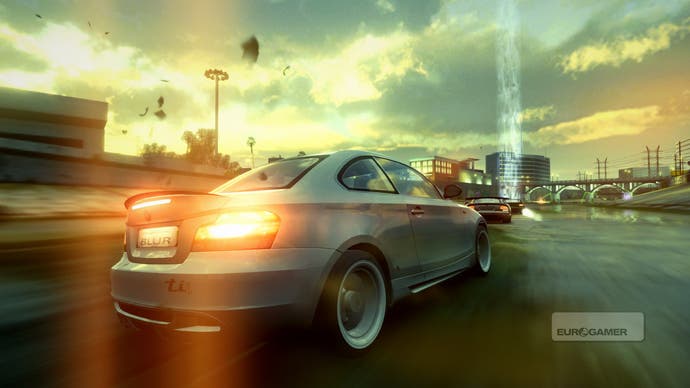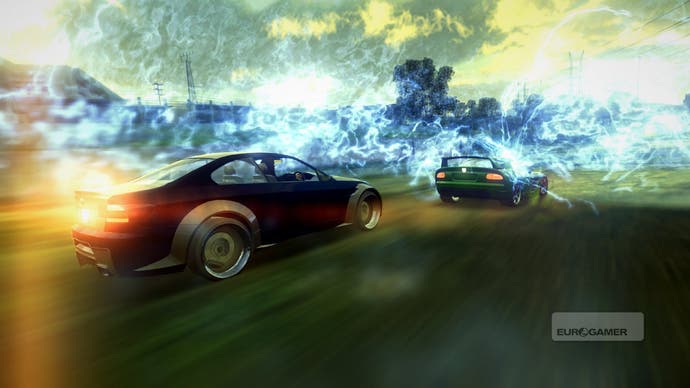Blur
Power-up to the people.
This is how Bizarre Creations wants to save racing games.
A field of 20 cars, licensed, tuned and modified: muscle cars, sleek tuner coupés, rusting vintage "rat cars" hiding monster engines, J-drift specials, off-roaders, not a Ferrari in sight. Lurid twilight skies brooding over trash-strewn wastelands. Sprawling, free-flowing tracks studded with jumps, giant aprons of cracked tarmac, corners shaped not by barriers and kerbs but hastily scattered traffic cones and destructible street furniture, arrows of light painted across buildings. Flash mobs and social networking and user-created content. Dark drum and bass.
And power-ups. Fantasy power-ups: bright, colour-coded neon crackles and waves of energy that shock, shunt and barge the opposition, as well as mines and speed boosts. Combined with the large, tightly-packed field of cars and broad tracks, they make for a bustling and chaotic race, a game that's less about technique than it is instinct and survival.
Project Gotham Racing this isn't. Bizarre's brilliant racing series for Microsoft - like its Dreamcast ancestor, Metropolis Street Racing - was never exactly a simulation racer. The tight-but-loose handling and the hint of score-attack about the kudos style system told you that Bizarre always had one foot in the arcade. But they were technical games, and with their beautifully-modelled production cars, demanding tracks and reverential dedication to the art and science of cornering, they were lumped in with the Gran Turismos and Forzas of this world more often than not.

That, the Liverpool studio has now decided, is just another cul-de-sac in a "stagnating" racing genre. Backed by new owners Activision, it's making a stab at the mass market with Blur. Talking to Bizarre staff at their offices, you'll hear huge admiration for games like Race Driver GRID and RACE Pro, but a determination to reach more people, to design something more accessible. Need for Speed gets mentioned, of course, but the names that keep cropping up are much older, examples of a "golden age" of racers for everyone: Road Rash, OutRun and the one blockbuster, multi-million-selling racing game that still exists: Mario Kart.
After playing through a four-track demo a few times you can add a few more names to its hall of fame: the gritty street glamour of Midnight Club, the futurism and weapon balance of WipEout, the combative, bodywork-shredding crashes of Burnout. And yes, PGR, not forsaken completely, but living on in the poised, tactile handling with its detailed physical feedback and those trademark drifts. It's just that it's now balanced on a sturdy, accommodating pillar rather than a knife-edge.
"In Gotham, the Ariel Atom was quite easy to handle," says lead designer Gareth Wilson. "But if you gave it to someone who didn't play racing games they'd smack into every wall, and go, 'This is crap, I'll go and play Halo, thank you.'" Earlier, in a presentation, Wilson explains that "we used to hate the gamer... We only liked you if you completed the whole game on Platinum, and less than one per cent did that. 20 per cent of people were playing on Steel."

Studio founder Martyn Chudley is more blunt. "Gotham was part of the problem," he says. He sums up its attitude as "look how f***ing clever we are".
Clever indeed, but also bored. After five racing games in the same mould Bizarre needed a change, even if that change would be hard to achieve. For a studio that had excelled at technical, high-skill, hardcore, leaderboard-driven score-attack games - not just with PGR but with The Club and Geometry Wars, too - breaking out of its own mindset wasn't easy. "The team, for ten years, had advocated reality and done it really well," says Wilson. "So yeah, it was tough, but everyone's on board now." It took months.
So if technique is out, what replaces it? Variety, says Bizarre, "big-boy bumper cars", rowdy competition, emotive excitement, a little strategy, a lot of fun, and hyper-real Hollywood showmanship. Still in: licensed cars, top-end graphics and audio, structural innovation and real-world locations.
Those will include deserts, suburbs and mountains as well as cities, and the latter are more likely to be represented by run-down back-streets than tourist traps. We see Los Angeles (a fairly familiar, benighted landscape of storm-drains and oil wells) and a Nevada desert setting littered with abandoned industrial architecture. We also know San Francisco, Spain and Tokyo will feature.



